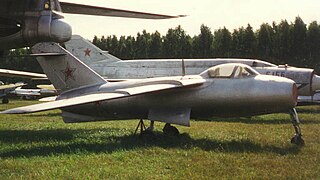
The Lavochkin La-15, was an early Soviet jet fighter and a contemporary of the Mikoyan-Gurevich MiG-15.

The Avro 707 is a British experimental aircraft built to test the tailless thick delta wing configuration chosen for the Avro 698 jet bomber, later named the Vulcan. In particular, the low-speed characteristics of such aircraft were not well known at the time. Aerodynamically, it was a one-third scale version of the Vulcan.

The Sukhoi Su-9 was an early jet fighter built in the Soviet Union shortly after World War II. The design began in 1944 and was intended to use Soviet-designed turbojet engines. The design was heavily influenced by captured German jet fighters and it was subsequently redesigned to use a Soviet copy of a German turbojet. The Su-9 was slower than competing Soviet aircraft and it was cancelled as a result. A modified version with different engines and a revised wing became the Su-11, but this did not enter production either. The Su-13 was a proposal to re-engine the aircraft with Soviet copies of the Rolls-Royce Derwent turbojet as well as to modify it for night fighting, but neither proposal was accepted.

The Yakovlev Yak-19 was a prototype Soviet fighter built in late 1940s. It was the first Soviet aircraft to be equipped with an afterburning turbojet, the Klimov RD-10F that was derived from the German Jumo 004 engine. Only two examples were built as it was rejected for service by the Soviet Air Force.

The Rolls-Royce RB.37 Derwent is a 1940s British centrifugal compressor turbojet engine, the second Rolls-Royce jet engine to enter production. Essentially an improved version of the Rolls-Royce Welland, itself a renamed version of Frank Whittle's Power Jets W.2B, Rolls inherited the Derwent design from Rover when they took over their jet engine development in 1943. Performance over the Welland was somewhat increased and reliability dramatically improved, making the Derwent the chosen engine for the Gloster Meteor and many other post-World War II British jet designs.
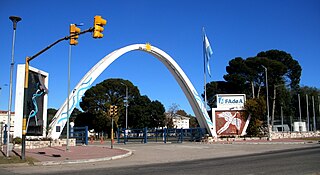
The Fábrica Argentina de Aviones SA (FAdeA), officially Fábrica Argentina de Aviones "Brigadier San Martín" S.A., is Argentina's main aircraft manufacturer. Founded on 10 October 1927 and located in Córdoba, for most of its existence it was known as Fábrica Militar de Aviones (FMA), until its privatization in the 1990s to Lockheed Martin. In 2009 the concession ended and the company is now wholly owned by the Argentine government.

The FMA IAe 33 Pulqui II was a jet fighter aircraft designed by Kurt Tank in the late 1940s in Argentina, under the Perón government, and built by the Fábrica Militar de Aviones (FMA). Embodying many of the design elements of the wartime Focke-Wulf Ta 183, an unrealized fighter project, the FMA envisioned the IAe 33 Pulqui II as a successor to the postwar Gloster Meteor F4 in service with the Fuerza Aérea Argentina. The Pulqui II's development was comparatively problematic and lengthy, with two of the four prototypes being lost in fatal crashes. Despite one of the prototypes being successfully tested in combat during the 1955 Revolución Libertadora, the political, economic and technical challenges faced by the project meant that the IAe 33 was unable to reach its full potential, and the Argentine government ultimately chose to purchase F-86 Sabres from the United States in lieu of continuing development of the indigenous fighter to production status.

The Fokker S.14 Machtrainer is a Dutch two-seater military training jet aircraft designed and manufactured by Fokker for the Royal Netherlands Air Force. It has the distinction of being one of the first dedicated jet-powered training aircraft to be produced in the world.

The FMA SAIA 90 was a cancelled air superiority fighter aircraft project, designed by the FMA with the collaboration of Dornier in the mid-1980s. The SAIA 90 was the last stage of the ACA project, which was started by the National Reorganization Process to develop an Argentine fighter aircraft.
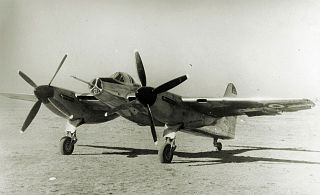
The I.Ae. 30 "Ñancú" was an Argentine twin piston engined fighter designed by the Instituto Aerotécnico in the late 1940s, similar to the de Havilland Hornet, but made of metal rather than wood. Only one prototype was completed; the project was abandoned in favour of the FMA I.Ae. 27 Pulqui I jet aircraft.

The I.Ae. 27 Pulqui I was an Argentine jet designed at the "Instituto Aerotecnico" in 1946. Only one prototype was completed; unsatisfactory performance led to the aircraft being superseded by a later design.
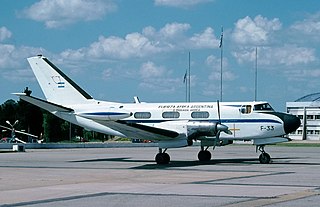
The I.A. 50 Guaraní II is an Argentine utility aircraft designed at the DINFIA in the early 1960s.

The DINFIA IA 35 Huanquero was a 1950s Argentine twin-engined general-purpose monoplane aircraft built by the DINFIA.
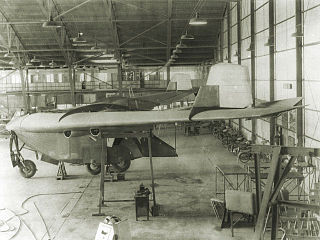
The DINFIA IA 38 was a 1960s Argentine four-engine experimental tailless transport aircraft, designed under the direction of Reimar Horten and based on the German Horten Ho VIII project and built by the DINFIA.

The Lavochkin La-152,, and its variants, was a jet fighter prototype designed and manufactured by the Lavochkin Design Bureau (OKB) shortly after the end of World War II. Derived from the Lavochkin La-150, the 152 used several different engines, but the program was canceled as other fighters with more powerful engines and swept wings showed more promise.
The Lavochkin La-168 was a jet fighter developed for the USSR. Like the better known Mikoyan MiG-15 which was ultimately selected and went on to become one of the most successful jet fighters of its era, the Lavochkin La-168 was designed in response to a 1946 request for an advanced swept-wing jet fighter capable of transonic performance. It was to use new turbojet based on the Rolls-Royce Nene in competition with the design bureaus of Artem Mikoyan and Mikhail Gurevich, and Aleksandr Yakovlev. A scaled down version of this aircraft would lead to the production of the La-15, which performed well but would be dropped in favor of the MiG-15.
The I.Ae. 48 was a prototype jet fighter of Argentine origin. It was to be developed after the I.Ae. 37 program was split with it becoming a subsonic trainer as the new, more powerful fighter, designated as the I.Ae. 48, with two podded engines under the wings and intended to reach Mach 2.2.(2700 km/h). However, both projects were canceled in 1960 as an economic measure, only a year before the I.Ae. 37 was to fly.

The National Aeronautics Museum "Brigadier Edmundo Civati Bernasconi" is an Argentine museum located in the city of Morón, Buenos Aires. Established in 1960, the museum is dedicated to the history of aviation, in particular the Argentine Air Force.

The Tupolev '73',, was a Soviet trijet medium bomber of the late 1940s. It lost out to the Ilyushin Il-28 'Beagle'.

The IA 36 Cóndor was a projected Argentine jet propelled mid-range airliner, designed in the early 1950s by Kurt Tank for the “Fábrica Militar de Aviones”. It was cancelled in 1958, with no prototypes built, but a full size wood mockup.


















